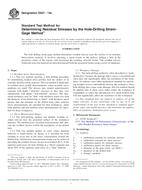Potřebujeme váš souhlas k využití jednotlivých dat, aby se vám mimo jiné mohly ukazovat informace týkající se vašich zájmů. Souhlas udělíte kliknutím na tlačítko „OK“.
ASTM E837-13a
Standard Test Method for Determining Residual Stresses by the Hole-Drilling Strain-Gage Method (Includes all amendments And changes 11/16/2020).
Automaticky přeložený název:
Standardní zkušební metoda pro stanovení zbytkových napětí, které Hole-vrtání Tenzometrické metody
NORMA vydána dne 15.9.2013
Informace o normě:
Označení normy: ASTM E837-13a
Poznámka: NEPLATNÁ
Datum vydání normy: 15.9.2013
Kód zboží: NS-48196
Počet stran: 16
Přibližná hmotnost: 48 g (0.11 liber)
Země: Americká technická norma
Kategorie: Technické normy ASTM
Kategorie - podobné normy:
Anotace textu normy ASTM E837-13a :
Keywords:
hole-drilling, integral method, residual stress measurement, strain gages, stress analysis, ICS Number Code 77.040.10 (Mechanical testing of metals)
Doplňující informace
| Significance and Use | ||
|
5.1 Summary: 5.1.1 Residual stresses are present in almost all materials. They may be created during the manufacture or during the life of the material. If not recognized and accounted for in the design process, residual stresses can be a major factor in the failure of a material, particularly one subjected to alternating service loads or corrosive environments. Residual stress may also be beneficial, for example, the compressive stresses produced by shot peening. The hole-drilling strain-gage technique is a practical method for determining residual stresses. |
||
| 1. Scope | ||
|
1.1 Residual Stress Determination : 1.1.1 This test method specifies a hole-drilling procedure for determining residual stress profiles near the surface of an isotropic linearly elastic material. The test method is applicable to residual stress profile determinations where in-plane stress gradients are small. The stresses may remain approximately constant with depth (“uniform” stresses) or they may vary significantly with depth (“non-uniform” stresses). The measured workpiece may be “thin” with thickness much less than the diameter of the drilled hole or “thick” with thickness much greater than the diameter of the drilled hole. Only uniform stress measurements are specified for thin workpieces, while both uniform and non-uniform stress measurements are specified for thick workpieces. 1.2 Stress Measurement Range: 1.2.1 The hole-drilling method can identify in-plane residual stresses near the measured surface of the workpiece material. The method gives localized measurements that indicate the residual stresses within the boundaries of the drilled hole. 1.2.2 This test method applies in cases where material behavior is linear-elastic. In theory, it is possible for local yielding to occur due to the stress concentration around the drilled hole. Satisfactory measurement results can be achieved providing the residual stresses do not exceed about 80 % of the material yield stress for hole drilling in a “thick” material and about 50% of the material yield stress in a “thin” material. 1.3 Workpiece Damage: 1.3.1 The hole-drilling method is often described as “semi-destructive” because the damage that it causes is localized and often does not significantly affect the usefulness of the workpiece. In contrast, most other mechanical methods for measuring residual stresses substantially destroy the workpiece. Since hole drilling does cause some damage, this test method should be applied only in those cases either where the workpiece is expendable, or where the introduction of a small shallow hole will not significantly affect the usefulness of the workpiece. 1.4 This standard does not purport to address all of the safety concerns, if any, associated with its use. It is the responsibility of the user of this standard to establish appropriate safety and health practices and determine the applicability of regulatory limitations prior to use. |
||
| 2. Referenced Documents | ||
|
Doporučujeme:
Aktualizace technických norem
Chcete mít jistotu, že používáte pouze platné technické normy?
Nabízíme Vám řešení, které Vám zajistí měsíční přehled o aktuálnosti norem, které používáte.
Chcete vědět více informací? Podívejte se na tuto stránku.




 Cookies
Cookies
